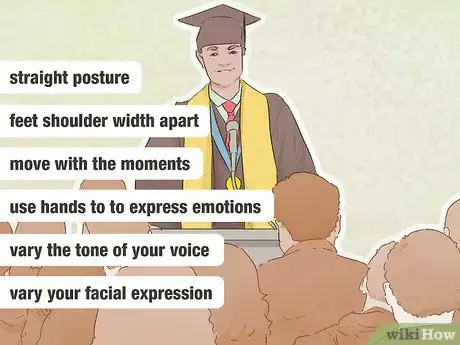This article was co-authored by Lynn Kirkham. Lynn Kirkham is a Professional Public Speaker and Founder of Yes You Can Speak, a San Francisco Bay Area-based public speaking educational business empowering thousands of professionals to take command of whatever stage they've been given - from job interviews, boardroom talks to TEDx and large conference platforms. Lynn was chosen as the official TEDx Berkeley speaker coach for the last four years and has worked with executives at Google, Facebook, Intuit, Genentech, Intel, VMware, and others.
There are 13 references cited in this article, which can be found at the bottom of the page.
This article has been viewed 24,422 times.
Speaking in public is an important skill throughout school and in life. Trying to master it can trigger fear and anxiety in many students.[1] Learning to talk confidently in front of an audience, whether big or small, is something that will benefit your students throughout their lives. Fortunately, there are a variety of creative techniques and approaches out there to help you teach your students how to speak effectively in public.
Steps
Beginning With the Basics
-
1Break the ice with simple introductions. Building up students’ abilities to speak publicly starts with getting them to simply talk to their classmates. Ask students to write down their name and to share something they think is interesting about themselves. Then go around the room and have each person introduce themselves to the class.
- If you have a particularly quiet or large group, you can work up to this by having students introduce themselves to the person next to them.
- A fun variant of this is to ask students to interview a partner in the class. Then the students introduce each other to the group.
-
2Foster a supportive environment with positive feedback. As the instructor it’s important for you to provide a good example for your students by giving lots of encouragement and praise to students for trying their best. Speaking in front of a group can be scary, but it’s easier if the group is kind and friendly. [2]
- Get the class more involved as listeners by asking them to identify 1-2 strengths in their classmates’ presentations.
Advertisement -
3Allow your students to lead a group activity or class discussion. Ask your students to take turns leading the class in an activity or discussion that they plan. This model for speaking takes some of the pressure off as it is not really a traditional presentation. However, it still requires the student to organize material and speak about it in front of the class.[3]
- Avoid calling the activity “public speaking,” because this can frighten students.[4]
-
4Incorporate low-stakes speaking opportunities into routine activities. Practice makes perfect, or at least better. So, rather than build students up to a few big deadlines, have them complete smaller, low-stakes presentations on a regular basis.[5]
- For example, you can begin each class by asking students to weigh in on a question you pose to them.
- Alternatively, you can let your students take turns proposing a question of the day.
- Give your students the freedom to discuss what they want to at least some of the time, as it’s much easier to talk when you are invested in the subject material. [6]
Calming Students’ Fears
-
1Practice deep breathing techniques with your students to calm nerves. Breathing and keeping the body relaxed are important when confronting a stressful presentation. Ask your students to learn and practice this basic relaxation approach before they speak: [7]
- Ask your students to find a quiet place where they can focus. Have them shake out their arms and legs, and blow air through their lips.
- Have students stand tall, raise their arms over their head, breathe deeply and exhale slowly as they lower their arms. Ask them to continue to focus on breathing, directing their breath into their stomach and exhaling calmly and slowly.[8]
EXPERT TIPLynn Kirkham is a Professional Public Speaker and Founder of Yes You Can Speak, a San Francisco Bay Area-based public speaking educational business empowering thousands of professionals to take command of whatever stage they've been given - from job interviews, boardroom talks to TEDx and large conference platforms. Lynn was chosen as the official TEDx Berkeley speaker coach for the last four years and has worked with executives at Google, Facebook, Intuit, Genentech, Intel, VMware, and others.Public Speaking Coach
 Lynn Kirkham
Lynn Kirkham
Public Speaking CoachCalm your nerves by getting to know people in the audience. Arrive early and introduce yourself to as many people as you can. You'll realize that they're ordinary human beings and not intimidating monsters. Once you get to know some of them, you'll see that no one goes to a speech to judge the speaker. The audience wants to support you and for you to deliver your speech well.
-
2Teach your students to use visualization to boost confidence. You can help your students learn to build themselves up before speaking. Ask students to take a few minutes before they present to close their eyes, breathe deeply and calmly, and visualize themselves successfully giving their presentation.[9]
-
3Ask your students to practice positive-affirmations to instill confidence. Students should draft a 1-2 sentence affirmation that stresses positive traits and abilities. Have your students practice reciting these in front of a mirror a few moments before they speak to the class.[10]
- For example, “I know what I’m talking about and people are interested in what I have to say,” is a good affirmation. Repeated, it can build confidence before a speech.
EXPERT TIPLynn Kirkham is a Professional Public Speaker and Founder of Yes You Can Speak, a San Francisco Bay Area-based public speaking educational business empowering thousands of professionals to take command of whatever stage they've been given - from job interviews, boardroom talks to TEDx and large conference platforms. Lynn was chosen as the official TEDx Berkeley speaker coach for the last four years and has worked with executives at Google, Facebook, Intuit, Genentech, Intel, VMware, and others.Public Speaking Coach
 Lynn Kirkham
Lynn Kirkham
Public Speaking CoachHave your students choose their intention or goal before giving a speech. Their intent might be to make excellent eye contact, make the audience love them, or to deliver their best speech ever. Visualizing their goal before starting changes their mindset from "I have to speak," to "I get to speak," which decreases their anxiety.
-
4Teach your students to stand in a power pose when they speak. If you stand like a starfish, with your feet spread to shoulder length, chin up, chest out, and with your hands on your hips, your body responds by reducing cortisol, the stress hormone, and increasing testosterone levels. Teach your students to practice this posture and encourage them to use it when they present to the class.[11]
- Body posture does make a difference in how you feel about yourself. Give your students practice standing in a power stance, smiling, and making eye contact.[12]
EXPERT TIPLynn Kirkham is a Professional Public Speaker and Founder of Yes You Can Speak, a San Francisco Bay Area-based public speaking educational business empowering thousands of professionals to take command of whatever stage they've been given - from job interviews, boardroom talks to TEDx and large conference platforms. Lynn was chosen as the official TEDx Berkeley speaker coach for the last four years and has worked with executives at Google, Facebook, Intuit, Genentech, Intel, VMware, and others.Public Speaking Coach
 Lynn Kirkham
Lynn Kirkham
Public Speaking CoachYour students need to master eye contact to become powerful public speakers. If your students aren't comfortable making eye contact, have them practice holding eye contact with someone they know in silence for several minutes. Do that five or six times. They can also work on maintaining eye contact with themselves in a mirror without getting distracted.
Developing Presentation Skills
-
1Encourage team presentations. Although working with others can be challenging, presenting as a team alleviates some of the pressure that speaking solo can carry. By diffusing the responsibility for the presentation across two or more students, the stress of the situation diminishes, and students can grow more comfortable speaking in front of a group.[13]
- Make sure that each student participates in the presentation so that shy or quiet students are not overshadowed by more boisterous peers.
-
2Ask students to share a recorded video presentation. Making video presentations is important in its own right, but many students may find it easier to present to a webcam than to a group of their peers. By asking students to prepare and show a video, you allow them to also see and hear themselves and it takes some of the pressure off.[14]
- Have your students host a follow-up Q&A where the class asks questions and they have to respond. This will help further develop their ability to think on their feet.[15]
-
3Assign small group presentations. Break students into small groups and have them present to eachother. By reducing the size of the audience, you’ll minimize the stress of speaking in front of others.[16]
- Build up to more formal, full-class presentations from these smaller breakout sessions.
- Involve students in the process by asking each student in the group to provide 1-2 pieces of constructive criticism to one another.
-
4Tell your students to make mistakes on purpose. Assign your students a project where they intentionally do something wrong. Then ask the rest of the class to identify what they did that was incorrect. You can help the students get over the worry of “messing up” while also teaching the “dos and don’ts” of public speaking.
- Much of the fear and anxiety surrounding public speaking has to do with worrying about mistakes.
- Another approach is to ask your students to say tongue twisters until they make a mistake. This can be fun and can help alleviate the stress of speaking in public with laughter.[17]
References
- ↑ https://www.psychologytoday.com/us/blog/smashing-the-brainblocks/201711/why-are-we-scared-public-speaking
- ↑ https://youtu.be/27-rAnFapk0?t=426
- ↑ https://www.facultyfocus.com/articles/effective-teaching-strategies/letting-students-lead-class-discussions/
- ↑ https://youtu.be/27-rAnFapk0?t=85
- ↑ https://www.forbes.com/sites/carminegallo/2018/09/23/dont-abolish-in-class-presentations-teach-students-to-enjoy-public-speaking/#2c3d8fa47ccb
- ↑ https://www.wgu.edu/heyteach/article/presentation-tips-students-take-fear-out-public-speaking1601.html
- ↑ https://www.psychologytoday.com/us/blog/smashing-the-brainblocks/201711/how-conquer-the-fear-public-speaking
- ↑ https://youtu.be/yyL7f8Ow45w
- ↑ https://www.businessinsider.com/tips-for-calming-nerves-before-a-speech-2014-6
- ↑ https://www.businessinsider.com/tips-for-calming-nerves-before-a-speech-2014-6
- ↑ http://www.bbc.com/capital/story/20140904-jitters-act-like-a-starfish
- ↑ https://www.businessinsider.com/tips-for-calming-nerves-before-a-speech-2014-6
- ↑ https://www.forbes.com/sites/carminegallo/2018/09/23/dont-abolish-in-class-presentations-teach-students-to-enjoy-public-speaking/#2c3d8fa47ccb
- ↑ https://www.forbes.com/sites/carminegallo/2018/09/23/dont-abolish-in-class-presentations-teach-students-to-enjoy-public-speaking/#2c3d8fa47ccb
- ↑ https://youtu.be/27-rAnFapk0?t=500
- ↑ https://youtu.be/27-rAnFapk0?t=261
- ↑ https://www.theedadvocate.org/help-child-overcome-public-speaking-fears/






































































